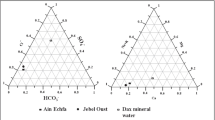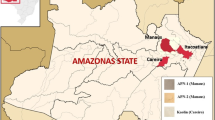Abstract
Clays and muds have been used for centuries as cosmetics or pharmaceutical products for various therapies. The suitability of muds and clays for health- and beauty-related applications depends on their physicochemical properties, mineralogical composition, particle characteristics and toxicity. In this work, the physicochemical characterization of 12 mud specimens from different natural spa resorts in Greece and one from Israel (Dead Sea) is presented. All specimens were sterilized at 121 °C for 20 min, because of their intended use. The Greek mud specimens were collected from various locations in Macedonia, Western Greece and Northeast Aegean. All muds were characterized concerning their mineralogical, chemical components as well as their morphological characteristics using appropriate methods [powder X-ray diffraction (XRD), thermogravimetric analysis (TGA), nitrogen absorption specific surface area measurements (BET), scanning electron microscopy and energy dispersive X-ray spectroscopy]. The concentrations of F−, Cl−, NO3− and SO42− anions at equilibrium with the mud specimens were measured by ion chromatography. Total calcium concentration was measured using atomic absorption spectroscopy, and the concentration of total N, C, H and S in the solids was measured using elemental analysis. Moreover, total phenolic concentration (TPC) in distilled water equilibrated with the mud specimens was measured as an index for their antioxidant properties. Several muds were found to present high TPC. Several of the examined mud specimens were found to have the potential use as pharmaceuticals or cosmetics. Based on the physicochemical characteristics of the mud specimens examined, possible improvement in their use and applicability has been suggested.






Similar content being viewed by others
References
Annegowda, H. V., Bhat, R., Min-Tze, L., Karim, A. A., & Mansor, S. M. (2012). Influence of sonication treatments and extraction solvents on the phenolics and antioxidants in star fruits. Journal of Food Science and Technology, 49(4), 510–514.
Bautista-Banos, S., Hernandez-Lauzardo, A. N., Velazquez-del Valle, M. G., Hernandez-Lopez, M., Ait Barka, E., Bosquez-Molina, E., et al. (2006). Chitosan as a potential natural compound to control pre and postharvest diseases of horticultural commodities. Crop Protection, 25(2), 108–118.
Bellometti, S., Giannini, S., Sartori, L., & Crepaldi, G. (1997). Cytokine levels in osteoarthrosis patients undergoing mud bath therapy. International Journal of Clinical Pharmacology Research, 17(4), 149–153.
Benedetti, S., Pagliarani, S., Benvenuti, F., Marini, D., Galli, T., Oliva, F., et al. (2007). Antioxidative effects of sulphurous water from macerata feltria thermal resort in patients with osteoarthritis. Progress in Nutrition, 9(1), 1–7.
Carretero, M. I., & Pozo, M. (2010). Clay and non-clay minerals in the pharmaceutical and cosmetic industries Part II. Active ingredients. Applied Clay Science, 47, 171–181.
Carrretero, M. I., Gomes, C. S. F., & Tateo, F. (2006). Clays and human health. Handbook of Clay Science, 1, 717–741.
Çelik Karakaya, M., Karakaya, N., Sarıoğlan, Ş., & Koral, M. (2010). Some properties of thermal muds of some spas in Turkey. Applied Clay Science, 48(3), 531–537.
Centini, M., Tredici, M. R., Biondi, N., Buonocore, A., Maffei Facino, R., & Anselmi, C. (2015). Thermal mud maturation: organic matter and biological activity. International Journal of Cosmetic Science, 37, 339–347.
Dolmaa, G., Tserenpil, Sh, Ugtakhbayar, O., Shevchenko, S. G., Kliba, L. V., & Voronkov, M. G. (2009). Characterization and organic compounds in peloids from Mongolia. Proceedings of the Mongolian Academy of Sciences, 4, 3–21.
Działo, M., Mierziak, J., Korzun, U., Preisner, M., Szopa, J., & Kulma, A. (2016). The potential of plant phenolics in prevention and therapy of skin disorders. International Journal of Molecular Sciences, 17(2), 160–201.
Errasfa, M., & Harzy, T. (2012). Sulphur thermal water improves blood lipids but not total anti-oxidant capacity in knee osteoarthritis patients. Shiraz E-Medical J., 13(2), 54–58.
Fakhfakh, E., Chakroun, I., Chaari, I., Medhioub, M., Rocha, F., Gomes, C., et al. (2005). Chemical and physical characterization of some Tunisian smectites for human healing use. Acta Geodynamics et Geomaterialia, 2(2), 138.
Ferrell, R. E. (2008). Medicinal clay and spiritual healing. Clays and Clay Minerals, 56(6), 751–760.
Földvári, M. (2011). Handbook of thermogravimetric system of minerals and its use in geological practice. Occasional Papers of the Geological Institute of Hungary, 213, 1–180.
Gomes, C., Carretero, M. I., Pozo, M., Maraver, F., Cantista, P., Armijo, F., et al. (2013). Peloids and pelotherapy: Historical evolution, classification and glossary. Applied Clay Science, 75–76, 28–38.
Harvey, A. L., Edrada-Ebel, R., & Quinn, R. J. (2015). The re-emergence of natural products for drug discovery in the genomics era. Nature Reviews Drug Discovery, 14(2), 111–129.
Hattori, I. (1963). Pelotherapy. In S. Licht (Ed.), Medical hydrology (pp. 273–290). USA: Connecticut.
Healy, W. B., & Wilson, G. F. (1971). Deposits of Rumen Epithelium associated with the ingestion of soil. New Zealand Journal of Agricultural Research, 14(1), 122–131.
Hill, M. J. (1997). Intestinal flora and endogenous vitamin synthesis. European Journal Cancer Prevention, 6(1), 43–45.
Jager, G., van der Boon, J., & Rauw, G. J. G. (1969). The influence of soil steaming on some properties of the soil on the growth and heading of winter glasshouse lettuce. I. Changes in the chemical and physical properties. Netherlands Journal of Agricultural Science, 17, 143–152.
Kerndorff, H., & Schnitzer, M. (1980). Sorption of metals on humic acid. Geochimica et Cosmochimica Acta, 44(11), 1701–1708.
Khiari, I., Mefteh, S., Sánchez-Espejo, R., Cerezo, P., Aguzzi, C., López-Galindo, A., et al. (2014). Study of traditional Tunisian medina clays used in therapeutic and cosmetic mud-packs. Applied Clay Science, 101, 141–148.
Lotrario, J. B., Stuart, B. J., Lam, T., Arands, R. R., O’Connor, O. A., & Kosson, D. S. (1995). Effects of sterilization methods on the physical characteristics of soil—implications for sorption isotherm analyses. Bulletin of Environmental Contamination and Toxicology, 54(5), 668–675.
Mihelcic, G., Kniewald, G., Ivanisevic, G., Cepelak, R., Mihelcic, V., & Vdovic, N. (2012). Physico-chemical characteristics of the peloid mud from Morinje Bay (eastern Adriatic coast, Croatia): Suitability for use in balneotherapy. Environmental Geochemistry and Health, 34(2), 191–198.
Odabaşı, E. (2014). Thermal mud molecular overview. TAF Preventive Medicine Bulletin, 13(3), 257–264.
Razavi Darbar, S., & Lakzian, A. (2007). Evaluation of chemical and biological consequences of soil sterilization methods. Caspian Journal of Environmental Sciences, 5(2), 87–91.
Rebelo, M., Viseras, C., López-Galindo, A., Rocha, F., & Ferreira da Silva, E. (2011). Characterization of Portuguese geological materials to be used in medical hydrology. Applied Clay Science, 51(3), 258–266.
Réblová, Z. (2012). Effect of temperature on the antioxidant activity of phenolic acids. Czech Journal of Food Sciences, 30(2), 171–177.
Rice-Evans, C. A., Miller, N. J., & Paganga, G. (1997). Antioxidant properties of phenolic Compounds. Trends in Plant Science, 2(4), 152–159.
Sarbon, N. M., Sandanamsamy, S., Kamaruzaman, S. F. S., & Ahmad, F. (2015). Chitosan extracted from mud crab (Scylla olivicea) shells: Physicochemical and antioxidant properties. Journal of Food Science and Technology, 52(7), 4266–4275.
Setnescu, T., Bancuta, J., Setnescu, R., Bancuta, R., Chilian, A., Bumbac, M., et al. (2013). Characterization of therapeutic muds collected at different sites in Roumania. Revue Roumaine de Chimie, 58(7–8), 599–610.
Sharma, K., Ko, E. Y., Assefa, A. D., Ha, S., Nile, S. H., Lee, E. T., et al. (2015). Temperature-dependent studies on the total phenolics, flavonoids, antioxidant activities, and sugar content in six onion varieties. Journal of Food and Drug Analysis, 23(2), 243–252.
Singh, B., & Gilkes, R. J. (1991). Concentration of iron oxides from soil clays by 5 m NaOH treatment: the complete removal of sodalite and kaolin. Clay Minerals, 26, 463–472.
Spilioti, E., Vargiami, M., Letsiou, S., Gardikis, K., Sygouni, V., Koutsoukos, P., et al. (2016). Biological properties of mud extracts derived from various spa resorts. Environmental Geochemistry and Health, 39(4), 821–833.
Trevors, J. (1996). Sterilization and inhibition of microbial activity in soil. Journal of Microbiological Methods, 26(1–2), 53–59.
Tserenpil, Sh, Dolmaa, G., & Voronkov, M. G. (2010). Organic matters in healing muds from Mongolia. Applied Clay Science, 49(1–2), 55–63.
Viseras, C., & Lopez-Galindo, A. (1999). Pharmaceutical applications of some spanish clays sepiolite, palygorskite, bentonite: some preformulation studies. Applied Clay Science, 14(1), 69–82.
Waterman, P. G., & Mole, S. (1994). Analysis of phenolic plant metabolites. In J. H. Lawton & G. E. Likens (Eds.), Methods in ecology. Oxford: Blackwell.
Zagklis, D. P., Vavouraki, A. I., Kornaros, M. E., & Paraskeva, C. A. (2015). Purification of olive mill wastewater phenols through membrane filtration and resin adsorption/desorption. Journal of Hazardous Materials, 285, 69–76.
Acknowledgements
This research has been co-financed by the European Union (European Social Fund-ESF) and Greek Secretariat of Research and Technology (NSRF 2013–2015) under the R&T Cooperation between Greece and Israel: “Physicochemical and Biological Characterization and Improvement of natural muds to produce high-added value products (Pharmamuds).” We specially thank Mr. George Georgiadis (Physis & Ousia Co.) for providing the mud specimens from Messolonghi and Ms. Liora Chilron (Anna Lotan Co.) for providing the mud sample from Israel. We also thank Mr. Venetatos (Pikrolimni Spa Co.), Pilotherapia Co., Mr. S. Nikoloutsopoulos, the municipality of Pydna and Mr. Giarmadouros for providing the mud samples from Kilkis, Kavala, Kyllini, Pieria and Lemnos correspondingly. Finally, we thank Associate Professor Michael Kornaros and the laboratory of “Biochemical Engineering & Environmental Technology (LBEET)” Chemical Engineering Department, University of Patras, for the use of laboratory facilities.
Author information
Authors and Affiliations
Corresponding author
Rights and permissions
About this article
Cite this article
Kamitsou, M.D., Sygouni, V., Kanellopoulou, D.G. et al. Physicochemical characterization of sterilized muds for pharmaceutics/cosmetics applications. Environ Geochem Health 40, 1449–1464 (2018). https://doi.org/10.1007/s10653-017-0066-8
Received:
Accepted:
Published:
Issue Date:
DOI: https://doi.org/10.1007/s10653-017-0066-8




